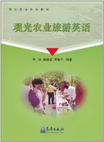观光农业旅游英语
2011-1
李侠、姬谦龙、 谭春平 气象出版社 (2011-01出版)
李侠 等 著
130
观光农业及生态旅游是以农村、农业、农民为载体的旅游活动,是旅游业的分支。本教材根据涉外导游工作对英语口语的需求而编写。《观光农业旅游英语》由十个单元组成,涉及九个话题:观光农业及生态旅游介绍、果园、菜园、酒庄、农家饭、森林游、少数民族村寨游、奶牛场以及教育农园。每个单元包括话题引入、听读理解、情景对话与角色扮演、练习和扩展阅读5个部分。内容的编排上既有场景介绍,又有游客参与体验农活的环节设计,以及学生充当地陪的角色练习。《观光农业旅游英语》重在训练学生“说”英语的能力,同时扩大相关背景知识。书后附有课文录音光盘。 《观光农业旅游英语》可以作为高职高专院校旅游专业、旅游管理专业、观光农业专业的英语教材,也可作为观光园、采摘园、民俗村、乡村游、酒庄等一线工作人员涉外接待、导游的参考用书,还可以作为对旅游感兴趣的、有对外交流需求的英语学习者的学习资料。
出版说明前言Unit 1 An Introduction to Agritourism and EcotourismPart 1 Warming-upPart 2 Topic listening and reading: A Brief Introduction to Agritourism and EcotourismPart 3 Learning how to communicate with people: Dialogue Role-play:In a tour guide training classPart 4 Building up your language stock: Translation exercisesPart 5 Supplements for reference:5.1 What makes a successful guide?5.2 Reading: Passage A:Agritourism in the World Passage B: Fashionable TourismUnit 2 Visiting the OrchardPart 1 Warming-upPart 2 Topic listening and reading= The Pick-Your-Own OrchardPart 3 Learning how to communicate with people. Dialogue Role-play:In the OrchardPart 4 Building up your language stock: Translation exercisesPart 5 Supplements for reference:Reading: Passage A: Fruit TreesPassage B: Why Holding Fruit on Trees May Limit Next Year's CropUnit 3 In the Kitchen GardenPart 1 Warming-upPart 2 Topic listening and reading: An Introduction to a Kitchen GardenPart 3 Learning how to communicate with people: Dialogue Role-play: In a vegetable gardenPart 4 Building up your language stock: Translation exercisesPart 5 Supplements for reference:Reading: Passage A: The CountrysidePassage B: Let Us Plant LettuceUnit 4 Visiting the Chateau (1)Part 1 Warming-upPart 2 Topic listening and reading: Welcome to Chateau AFIPPart 3 Learning how to communicate with people: Dialogue Role-play: In a chateauPart 4 Building up your language stock: Translation exercisesPart 5 Supplements for reference:Reading: Passage A: A Brief Introduction to the World Famous WinePassage B: New Understanding of How Plants Use WaterUnit 5 Visiting the Chateau (2)Part 1 Warming-upPart 2 Topic listening and reading: The Pairing of Wine and FoodPart 3 Learning how to communicate with people: Dialogue Role-play:At the Wine HousePart 4 Building up your language stock: Translation exercisesPart 5 Supplements for reference:Reading: Passage A: Wine Appreciation ABCPassage B: Why Grafting Still Fits Nicely into Agriculture Unit 6 In the Farm Food RestaurantPart 1 Warming-upPart 2 Topic listening and reading: Farm FoodPart 3 Learning how to communicate with people:Dialogue Role-play: In a farm food restaurantPart 4 Building up your language stock: Translation exercisesPart 5 Supplements for reference:Reading: Passage A: Chinese FoodPassage B: Welcome to the Vegetable Garden!Unit 7 Forest RecreationPart 1 Warming-upPart 2 Topic listening and reading: A Brief Introduction to Forest RecreationPart 3 Learning how to communicate with people: Dialogue Role-play: In the lounge of a hotelPart 4 Building up your language stock: Translation exercisesPart 5 Supplements for reference:Reading: Passage A: ForestsPassage B: Deforestation Decreased Over the Past 10 Years Unit 8 Visiting Ethnic Minority VillagePart 1 Warming-upPart 2 Topic listening and reading: The Chinese Ethnic MinoritiesPart 3 Learning how to communicate with people:Dialogue Role-play: On the bus to a Miao ethnic villagePart 4 Building up your language stock: Translation exercisesPart 5 Supplements for reference.Reading: Passage A: Instructions for Tourists in Ethnic Minority AreasPassage B:China's Five Ethnic Minority Autonomous RegionsUnit 9 Visiting the Diary FarmPart 1 Warming-upPart 2 Topic listening and reading: Diary FarmPart 3 Learning how to communicate with people:Dialogue Role-play: On a diary farmPart 4 Building up your language stock: Translation exercisesPart 5 Supplements for reference:Reading: Passage A: Milking by MachinesPassage B: New Alliance to Study Greenhouse Gases in AgricultureUnit 10 Visiting the Educational FarmPart 1 Warming-upPart 2 Topic listening and reading: An Introduction to anEducational FarmPart 3 Learning how to communicate with people:Dialogue Role-play: On an educational farmPart 4 Building up your language stock: Translation exercisesPart 5 Supplements for reference.Reading: Passage A: Soilless CultivationPassage B: Understanding Farm Animals Begins with a NameKeys to the exercisesUnit 1 Introduction to Agritourism and EcotourismUnit 2 Visiting the OrchardUnit 3 In the Kitchen GardenUnit 4 Visiting the Chateau(1)Unit 5 Visiting the Chatean(2)Unit 6 In the Farm Food RestaurantUnit 7 Forest RecreationUnit 8 Visiting the Ethnic Minority VillageUnit 9 Visiting the Diary FarmUnit 10 Visiting the Educational FarmGlossary 1 (按课文顺序)Glossary 2 (总词汇表)参考文献
版权页:插图:The pick-your-own orchard is usually open from mid-April to November. In an orchard, you can take a strollz, breathing the fresh air, and enjoying quality time with your family and friends. The fun starts in spring as varieties of fruit trees blossom. Stretches of white and pink blossoms, to which is drawn an analogy with snow, send forth a delicate scent3. Visiting orchards for the blossoms is a really rewarding experience——an appreciation of one of the most beautiful times of the year! Then as summer fades, the picking season comes. Visitors can pick berries like strawberries or cherries which mature earliest. When autumn——the fruitful time of the year hits full swing in October, the orchard hits its peak with more fruit4 than you can imagine. Going to the orchard to pick the fruit personally or buy fresh fruit just picked by the farmers is a good choice for you as you can spend your weekend returning to nature.The fruit produced in these orchards is coo-fruit, a term which is an assurance that you are buying quality fruit whose growing practices are sensitive and respectful to the environments. The farmers use a combination of old farming methods and leading- edge technologies to grow fruit that preserve the balance of the ecology of the orchard, and focus upon the use of natural methods and minimal spray6. These growing and spray methods may cost more than standard practices, but it's worth the effort and money. You' 11 agree once you have a taste of the fruit.
《观光农业旅游英语》是观光农业系列教材之一。
